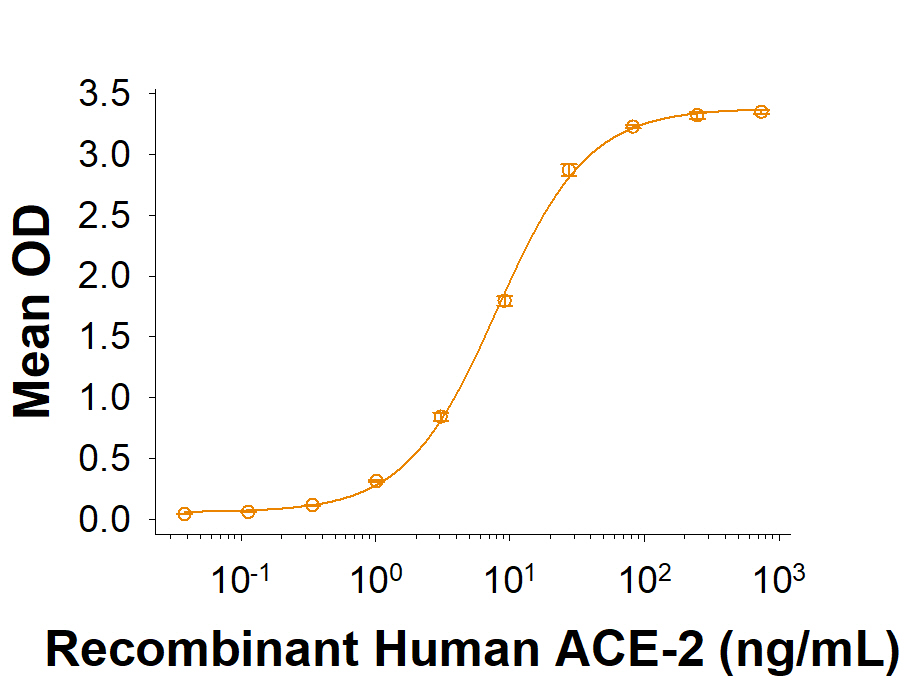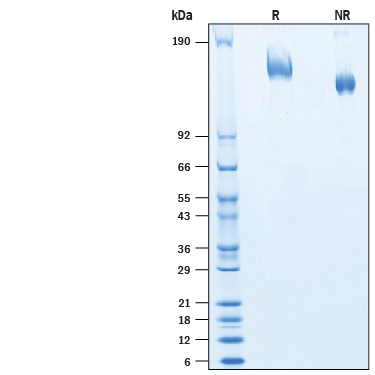Recombinant BatCoV RaTG13 Spike (GCN4-IZ) His Protein, CF Summary
Product Specifications
| BatCoV RaTG13 Spike (Val16-Pro1209) Accession # QHR63300.2 | GCN4-IZ | HHHHHH |
| N-terminus | C-terminus | |
Analysis
Product Datasheets
Carrier Free
CF stands for Carrier Free (CF). We typically add Bovine Serum Albumin (BSA) as a carrier protein to our recombinant proteins. Adding a carrier protein enhances protein stability, increases shelf-life, and allows the recombinant protein to be stored at a more dilute concentration. The carrier free version does not contain BSA.
In general, we advise purchasing the recombinant protein with BSA for use in cell or tissue culture, or as an ELISA standard. In contrast, the carrier free protein is recommended for applications, in which the presence of BSA could interfere.
10688-CV
| Formulation | Lyophilized from a 0.2 μm filtered solution in PBS with Trehalose. |
| Reconstitution | Reconstitute at 500 μg/mL in PBS. |
| Shipping | The product is shipped at ambient temperature. Upon receipt, store it immediately at the temperature recommended below. |
| Stability & Storage: | Use a manual defrost freezer and avoid repeated freeze-thaw cycles.
|
Scientific Data
 View Larger
View Larger
Recombinant BatCoV RaTG13 Spike (GCN4-IZ) His-tag (Catalog # 10688-CV) binds Recombinant Human ACE-2 Fc Chimera (10544-ZN) in a functional ELISA.
 View Larger
View Larger
2 μg/lane of Recombinant BatCoV RaTG13 Spike (GCN4-IZ) His-tag (Catalog # 10688-CV) was resolved with SDS-PAGE under reducing (R) and non-reducing (NR) conditions and visualized by Coomassie® Blue staining, showing bands at 145-165 kDa.
Reconstitution Calculator
Background: Spike
SARS-CoV-2, which causes the global pandemic coronavirus disease 2019 (Covid-19), belongs to a family of viruses known as coronaviruses that also include MERS-CoV and SARS-CoV-1. The bat coronavirus RaTG13 was identified as the closest known relative and likely origin for SARS-Cov-2, though how SARS-CoV-2 evolved to infect humans remains unclear. Coronaviruses are commonly comprised of four structural proteins: Spike protein (S), Envelope protein (E), Membrane protein (M) and Nucleocapsid protein (N) (1). The S protein is a homotrimeric glycoprotein, with each ~180-kDa monomer consisting of two subunits, S1 and S2, and it mediates membrane fusion and viral entry (2). As with most coronaviruses, proteolytic cleavage of the S protein into two distinct peptides, S1 and S2 subunits, is required for activation. The S1 subunit is focused on attachment of the protein to the host receptor while the S2 subunit is involved with cell fusion (3-5). A metallopeptidase, angiotensin-converting enzyme 2 (ACE2), has been identified as a functional receptor for SARS-CoV-2 through interaction with a receptor binding domain (RBD) located at the C-terminus of S1 subunit (6, 7). The S protein of RaTG13 shares 76% and 97% amino acid (aa) sequence identity with the S protein of SARS-CoV-1 and SARS-CoV-2, respectively. Despite high aa identity to SARS-CoV-2, five of the six key amino acids involved in ACE2 binding are different in bat RaTG13, leading to >1000 fold weaker binding to human ACE2 (8, 9). Polyclonal antibodies to the RBD of the SARS-CoV-2 S1 subunit have been shown to inhibit interaction with the ACE2 receptor, confirming RBD as an attractive target for vaccinations or antiviral therapy (10). There is also promising work showing that the RBD may be used to detect presence of neutralizing antibodies present in a patient's bloodstream, consistent with developed immunity after exposure to the SARS‑CoV‑2 virus (11).
- Wu, F. et al. (2020) Nature 579:265.
- Tortorici, M.A. and D. Veesler (2019) Adv. Virus Res. 105:93.
- Bosch, B.J. et al. (2003) J. Virol. 77:8801.
- Belouzard, S. et al. (2009) Proc. Natl. Acad. Sci. 106:5871.
- Millet, J.K. and G. R. Whittaker (2015) Virus Res. 202:120.
- Li, W. et al. (2003) Nature 426:450.
- Wong, S.K. et al. (2004) J. Biol. Chem. 279:3197.
- Malayia, J. et al. (2020) J Med. Virol. https://doi.org/10.1002/jmv.26261.
- Wrobel, A.G. et al. (2020) Nat. struct. Mol. Biol. https://doi.org/10.1038/s41594-020-0468-7.
- Tai, W. et al. (2020) Cell. Mol. Immunol. https://doi.org/10.1016/j.it.2020.03.007.
- Okba, N. M. A. et al. (2020) Emerg. Infect. Dis. https://doi.org/10.3201/eid2607.200841.
FAQs
No product specific FAQs exist for this product, however you may
View all Proteins and Enzyme FAQsReviews for Recombinant BatCoV RaTG13 Spike (GCN4-IZ) His Protein, CF
There are currently no reviews for this product. Be the first to review Recombinant BatCoV RaTG13 Spike (GCN4-IZ) His Protein, CF and earn rewards!
Have you used Recombinant BatCoV RaTG13 Spike (GCN4-IZ) His Protein, CF?
Submit a review and receive an Amazon gift card.
$25/€18/£15/$25CAN/¥75 Yuan/¥1250 Yen for a review with an image
$10/€7/£6/$10 CAD/¥70 Yuan/¥1110 Yen for a review without an image
